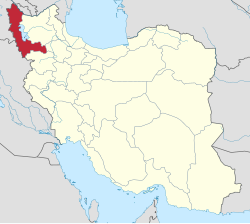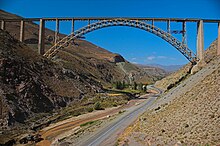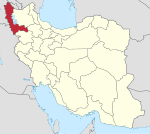Khoy County
Khoy County
Persian: شهرستان خوی | |
|---|---|
 Location of Khoy County in West Azerbaijan province (top center, pink) | |
 Location of West Azerbaijan province in Iran | |
| Coordinates: 38°39′N 44°50′E / 38.650°N 44.833°E[1] | |
| Country | Iran |
| Province | West Azerbaijan |
| Capital | Khoy |
| Districts | Central, Ivughli, Qatur, Safayyeh |
| Population (2016)[2] | |
• Total | 348,664 |
| Time zone | UTC+3:30 (IRST) |
Khoy County (Persian: شهرستان خوی) is in West Azerbaijan province, Iran. Its capital is the city of Khoy.[3]
History
[edit]Khoy was named in ancient times for the salt mines that made it an important spur of the Silk Route.[4] 3000 years ago, a city had existed on the area where Khoy is located nowadays, but its name became Khoy only from 14 centuries ago.[5] In 714 BC, Sargon II passed the region of which Khoy is part of in a campaign against Urartu.[5]
In the Parthian period, Khoy was the gateway of the Parthian Empire in the Northwest.[5] Around 37 BC, Marc Anthony had crossed the plain that is located between Khoy and Marand during one of the many and frequent Roman–Parthian Wars.[5]
One of the important historic elements of the city's Khoy in the county is the St. Sourp Sarkis church, one of the many churches in the county. Armenian documents wrote that the date of the making has to be either 332 or 333 AD.[5] In the city of Khoy and its surrounding villages, churches are seen and it is reported that Armenians have always been comprising a significant amount of the city's population, but the city was never an "Armenian city" (as in comprising a vast majority).[5]
Modern period
[edit]This article needs additional citations for verification. (June 2024) |
Khoy city was fortified at various times in its history, most recently by the Qajar dynasty in the nineteenth century.
After the death of Nadir Shah Afshar in 1747, Khoy and its immediate surroundings broke away from central government of Iran like several other regions of Iran, including what is now Georgia and some of the northern Caucasian Khanates comprising the northwestern territories of Iran.
Khoy became the centre of the newly established Khanate of Khoy (1747–1813) which was loyal to the central government only when it was powerful (like during Karim Khan's reign), and autonomous when the central role was weak. The return of Khoy to the central government of Iran was during the beginning of Qajar period during Agha Mohammad Khan's reign.
Khoy was attacked in 1827 by the Russian Empire who was attempting to seize the last of the Caucasian territories of Iran comprising Armenia and what is now Azerbaijan during the Russo-Persian War (1826–1828). The war, which mainly razed in the extremely nearby South Caucasus region eventually happened to moved deeper south as well.
Until 1828, Khoy had a large number of Armenians, however, the Treaty of Turkmenchay following the outcome of the 1826–1828 war and the victory over the neighbouring Ottoman Empire as concluded in the Treaty of Adrianople, encouraged the mass resettlement of Armenians from both Turkey and Iran in the Russian-controlled territory of modern Armenia. In the mid-1800s some of them immigrated to eastern Armenia, which by then had just become part of the Russian Empire. However, a small Armenian population remains living in Khoy city and county.
Eli Smith notes in his "Missionary Researches in Armenia: Including a Journey through Asia Minor, an into Georgia and Persia" released in 1834 that he and his group had heard while passing through Khoy that the city had between 4000 and 7000 Muslim families, while only about 100 Armenian families were left.[6] He noted further that in the immediate villages around Khoy city there were a few more Armenians, but the vast majority had migrated to the north of the Aras river following Russia's victory over Persia in 1828 and the encouraged settling in the newly incorporated Russian regions of Eastern Armenia.
In 1911 Khoy was occupied by Ottoman troops, followed in World War I by Russian troops, who withdrew in 1917. In World War II it was again occupied by Soviet troops, who remained until 1946.
Administrative history
[edit]After the 2006 National Census, the villages of Dizaj Diz,[7] Qatur,[8] and Zurabad[9] were elevated to city status. In addition, Chaypareh District was separated from the county in the establishment of Chaypareh County.[10]
Demographics
[edit]Language
[edit]Today, Khoy County is mainly populated by Azerbaijani people. The Armenians and Assyrians have largely fled and left the region due to massacres before and after the First World War. [citation needed]
Population
[edit]At the time of the 2006 census, the county's population was 365,573 in 85,550 households.[11] The following census in 2011 counted 354,309 people in 96,367 households.[12] The 2016 census measured the population of the county as 348,664 in 101,130 households.[2]
Administrative divisions
[edit]Khoy County's population history and administrative structure over three consecutive censuses are shown in the following table.
| Administrative divisions | 2006[11] | 2011[12] | 2016[2] |
|---|---|---|---|
| Central District | 260,854 | 288,565 | 288,269 |
| Dizaj RD | 17,516 | 19,493 | 19,681 |
| Firuraq RD | 13,116 | 13,708 | 14,219 |
| Gowharan RD | 9,821 | 10,799 | 11,161 |
| Qarah Su RD | 17,600 | 9,977 | 10,271 |
| Rahal RD | 16,190 | 16,897 | 16,620 |
| Dizaj Diz (city) | 7,896 | 8,282 | |
| Firuraq (city) | 7,903 | 8,837 | 9,190 |
| Khoy (city) | 178,708 | 200,958 | 198,845 |
| Chaypareh District[a] | 42,225 | ||
| Churs RD | 4,995 | ||
| Qarah Zia ol Din RD | 5,785 | ||
| Hajjilar RD | 8,856 | ||
| Qarah Zia ol Din (city) | 22,589 | ||
| Ivughli District | 17,915 | 17,603 | 16,259 |
| Ivughli RD | 8,413 | 8,489 | 7,303 |
| Valdian RD | 6,220 | 5,947 | 5,636 |
| Ivughli (city) | 3,282 | 3,167 | 3,320 |
| Qatur District | 24,407 | 26,583 | 24,591 |
| Qatur RD | 14,894 | 12,448 | 11,105 |
| Zeri RD | 9,513 | 9,472 | 8,339 |
| Qatur (city) | 4,663 | 5,147 | |
| Safayyeh District | 20,172 | 21,558 | 19,543 |
| Aland RD | 7,160 | 8,511 | 7,071 |
| Sokmanabad RD | 13,012 | 11,808 | 11,325 |
| Zurabad (city) | 1,239 | 1,147 | |
| Total | 365,573 | 354,309 | 348,664 |
| RD = Rural District | |||
Geography and climate
[edit]Khoy is located in the mountains, so the weather is very cold in winter and cool in summer. Spring weather in this city is very pleasant. The city is located in the vicinity of mountains such as Chelekhaneh Mount and Avrin Mount (The highest mountain of West Azarbaijan Province).
Transportation
[edit]
Airlines and destinations
[edit]Khoy Airport (IATA: KHY, ICAO: OITK) is an airport and bus station in Khoy, Iran.
| Airlines | Destinations |
|---|---|
| Iran Aseman Airlines | Tehran-Mehrabad |
Tourism
[edit]
It is well known for the tomb of Shams Tabrizi, renowned Iranian poet.
Gallery
[edit]See also
[edit]![]() Media related to Khoy County at Wikimedia Commons
Media related to Khoy County at Wikimedia Commons
Notes
[edit]- ^ Transferred to Chaypareh County[10]
References
[edit]- ^ OpenStreetMap contributors (25 September 2024). "Khoy County" (Map). OpenStreetMap (in Persian). Retrieved 25 September 2024.
- ^ a b c Census of the Islamic Republic of Iran, 1395 (2016): West Azerbaijan Province. amar.org.ir (Report) (in Persian). The Statistical Center of Iran. Archived from the original (Excel) on 30 August 2022. Retrieved 19 December 2022.
- ^ Habibi, Hassan (c. 2023) [Approved 21 June 1369]. Approval of the organization and chain of citizenship of the elements and units of the national divisions of West Azerbaijan province, centered in the city of Urmia. lamtakam.com (Report) (in Persian). Ministry of the Interior, Defense Political Commission of the Government Council. Notification 82808/T137. Archived from the original on 20 December 2023. Retrieved 20 December 2023 – via Lam ta Kam.
- ^ Andrew Burke, Iran pp. 138. Lonely Planet. ISBN 1742203493
- ^ a b c d e f Lida Balilan Asl, Elham Jafari. "Khoy's Expansion from Early Islam to Late Qajar According to Historical Documents" published spring 2013. vol 3
- ^ Eli Smith. "Missionary Researches in Armenia: Including a Journey through Asia Minor, an into Georgia and Persia" pp 315. G. Wightmann, 1834
- ^ Davodi, Parviz (c. 2023) [Approved 29 July 1386]. Letter of approval regarding the conversion of Dizaj Diz village from the functions of Qarah Su Rural District in the Central District of Khoy County in West Azerbaijan province to Dizaj Diz city. lamtakam.com (Report) (in Persian). Ministry of the Interior, Political-Defense Commission of the Government Board. Proposal 93023/42/1/4; Notification 166177/T38077K. Archived from the original on 23 December 2023. Retrieved 23 December 2023 – via Lam ta Kam.
- ^ Davodi, Parviz (c. 2012) [Approved 22 December 1380]. Approval letter regarding the conversion of Qatur village from the functions of Qatur Rural District, Qatur District of Khoy County in West Azerbaijan province to Qatur city. rc.majlis.ir (Report) (in Persian). Ministry of Interior, Political-Defense Commission of the Government Board. Proposal 93023/42/4/1; Notification 166181/T38077K. Archived from the original on 10 February 2012. Retrieved 23 December 2023 – via Islamic Parliament Research Center.
- ^ Rahimi, Mohammadreza (19 December 2016). "Four new cities were added to the map of national divisions; with some changes in the geography of three provinces of the country". dolat.ir (in Persian). Ministry of the Interior, Political and Defense Commission. Archived from the original on 10 December 2017. Retrieved 23 December 2023 – via Secretariat of the Government Information Council.
- ^ a b Davodi, Parviz (24 January 1393) [Approved 18 September 1386]. Approval letter regarding reforms of national divisions in West Azerbaijan province. rc.majlis.ir (Report) (in Persian). Ministry of the Interior, Political-Defense Commission of the Government Board. Proposal 138613/42/4/1; Notification 156165/T32690K. Archived from the original on 13 April 2014. Retrieved 21 November 2023 – via Islamic Parliament Research Center.
- ^ a b Census of the Islamic Republic of Iran, 1385 (2006): West Azerbaijan Province. amar.org.ir (Report) (in Persian). The Statistical Center of Iran. Archived from the original (Excel) on 20 September 2011. Retrieved 25 September 2022.
- ^ a b Census of the Islamic Republic of Iran, 1390 (2011): West Azerbaijan Province. irandataportal.syr.edu (Report) (in Persian). The Statistical Center of Iran. Archived from the original (Excel) on 20 January 2023. Retrieved 19 December 2022 – via Iran Data Portal, Syracuse University.






